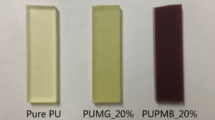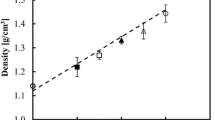Abstract
Polyurea is a thermoset elastomer with a wide range of implementations in industrial and biomechanical applications. In the past two decades, bulk polyurea was heavily investigated under different environmental, operating, and loading conditions. The further exploitation of the superior thermomechanical properties of polyurea necessitates the exploration of smaller length scales, e.g., microscales and nanoscales. Thus, the objective of this research was to fabricate cross-linked polyurea microspheres, which was hypothesized to inherit some of the properties of the bulk polyurea. While the production yield was found to be low, the resulting polyurea microspheres exhibit the hallmark characteristics of their bulk counterpart. The microspheres, fabricated by a modified precipitation polymerization process, were examined with a scanning electron microscope showing the microspheres to have a highly textured surface morphology and an average diameter of 2.4 ± 2.9 µm. Using FTIR spectroscopy and a thermogravimetric analyzer, the microspheres were found to have inherited the overall chemical structure and hygrothermal properties of bulk polyurea. Using an atomic force microscope, the elastic modulus of the microspheres was found to be 114.75 ± 40.71 MPa, four times stiffer than that of bulk polyurea. With such disparity of the elastic modulus, the polyurea microspheres can be used as a reinforcement phase in future polymer–polymer composites.





Similar content being viewed by others
References
Aboudi J, Arnold SM, Bednarcyk BA (2012) Micromechanics of composite materials: a generalized multiscale analysis approach. Butterworth-Heinemann, Oxford
Barsoum RGS (2015) Elastomeric polymers with high rate sensitivity: applications in blast, shockwave, and penetration mechanics. William Andrew, New York
Citron JK. Biomechanical Impact Management Using Polyurea [Internet]. University of California, Los Angeles; 2012 [cited 2020 Feb 3]. Available from: https://search.proquest.com/openview/4657e3b7f041ecba4f0eab31f4b38e7e/1?pq-origsite=gscholar&cbl=18750&diss=y
Gupta V, Citron JK, Youssef G 2013 Material for mitigating impact forces with collision durations in nanoseconds to milliseconds range
Gupta V, Youssef G (2014) Orientation-dependent impact behavior of polymer/EVA bilayer specimens at long wavelengths. Exp Mech 54:1133–1137
Xue L, Mock W, Belytschko T (2010) Penetration of DH-36 steel plates with and without polyurea coating. Mech Mater 42:981–1003
Henningsen J (2002) Polyurea: leading a revolution in coating technology. Paint Coat Ind 18:28–32
Jain A, Youssef G, Gupta V (2013) Dynamic tensile strength of polyurea-bonded steel/E-glass composite joints. J Adhes Sci Technol 27:403–412
Barsoum GS, Dudt PJ (2002) The fascinating behaviors of ordinary materials under dynamic conditions, 11–14. Ammtiac Q 4:11–14
Gupta V, Crum R, Gámez C, Ramirez B, Le N, Youssef G, Citron J, Kim A, Jain A, Misra U (2015) Adhesive and ultrahigh strain rate properties of polyurea under tension, tension/shear, and pressure/shear loadings with applications to multilayer armors. In: Elastomeric Polymers with High Rate Sensitivity: Applications in Blast, Shockwave, and Penetration Mechanics, vol 1. Elsevier Oxford, UK, pp 71–92
Grujicic M, Bell WC, Pandurangan B, He T (2010) Blast-wave impact-mitigation capability of polyurea when used as helmet suspension-pad material. Mater Des 31:4050–4065
Youssef G, Gupta V (2013) Resonance in polyurea-based multilayer structures subjected to laser-generated stress waves. Exp Mech 53:145–154
Roland CM, Twigg JN, Vu Y, Mott PH (2007) High strain rate mechanical behavior of polyurea. Polymer 48:574–578
Li C, Lua J (2009) A hyper-viscoelastic constitutive model for polyurea. Mater Lett 63:877–880
Youssef G, Whitten I (2017) Dynamic properties of ultraviolet-exposed polyurea. Mech Time-Dependent Mater 21(3):351–363
George Y, Brinson J, Whitten I (2018) The effect of ultraviolet radiation on the hyperelastic behavior of polyurea. J Polym Environ 26(1):183–190
Whitten I, Youssef G (2016) The effect of ultraviolet radiation on ultrasonic properties of polyurea. Polym Degrad Stab 123:88–93
Jiang X, Kong XZ, Zhu X (2011) A novel protocol for the preparation of uniform polymer microspheres with high yields through step polymerization of isophorone diisocyanate. J Polym Sci Part Polym Chem 49:4492–4497
Xu J, Han H, Zhang L, Zhu X, Jiang X, Kong XZ (2014) Preparation of highly uniform and crosslinked polyurea microspheres through precipitation copolymerization and their property and structure characterization. RSC Adv 4:32134–32141
Reed N, Huynh NU, Rosenow B, Manlulu K, Youssef G (2019) Synthesis and characterization of elastomeric polyurea foam. J Appl Polym Sci 137:48839
Youssef G, Reed N. Scalable manufacturing method of property-tailorable polyurea foam [Internet]. 2020 [cited 2020 Apr 3]. Available from: https://patents.google.com/patent/US20200071483A1/en
Youssef G, Reed N, Huynh NU, Rosenow B, Manlulu K (2020) Experimentally-validated predictions of impact response of polyurea foams using viscoelasticity based on bulk properties. Mech Mater. https://doi.org/10.1016/j.mechmat.2020.103432
Do S. Synthesis and Characterization of Polyurea-Polyurea Composite [Internet]. San Diego State University; 2018. Available from: https://search.proquest.com/openview/73f7ef28c0be7bfdf237c913ff315c9e/1?pq-origsite=gscholar&cbl=18750&diss=y
Do S, Rosenow B, Reed N, Mohammed A, Manlulu K, Youssef G (2019) Fabrication, characterization, and testing of novel polyurea foam. PU Mag Int 16:104–107
Do S, Stepp S, Youssef G (2020) Quasi-static and dynamic characterization of Polyurea microspheres reinforced polyurea matrix composite. Mater Today Commun 25:101464
Kim H, Citron J, Youssef G, Navarro A, Gupta V (2012) Dynamic fracture energy of polyurea-bonded steel/E-glass composite joints. Mech Mater 45:10–19
Pangon A, Dillon GP, Runt J (2014) Influence of mixed soft segments on microphase separation of polyurea elastomers. Polymer 55:1837–1844
Jiang X, Yu Y, Li X, Kong XZ (2017) High yield preparation of uniform polyurea microspheres through precipitation polymerization and their application as laccase immobilization support. Chem Eng J 328:1043–1050
Awad WH, Wilkie CA (2010) Investigation of the thermal degradation of polyurea: the effect of ammonium polyphosphate and expandable graphite. Polymer 51:2277–2285
Shaik AM, Huynh NU, Youssef G (2020) Micromechanical behavior of ultraviolet-exposed polyurea. Mech Mater 140:103244
Oliver WC, Pharr GM (1992) An improved technique for determining hardness and elastic modulus using load and displacement sensing indentation experiments. J Mater Res 7(6):1564–1583
Acknowledgements
The research leading to these results was supported in part by the United States Department of Defense under Grant Agreement No. W911NF-14-1-0039 and W911NF-18-1-0477. The research was also supported by internal funds from San Diego State University. The authors also acknowledge the use of equipment at the San Diego State University Electron Microscopy Facility acquired by NSF instrumentation grant DBI-0959908.
Author information
Authors and Affiliations
Corresponding author
Additional information
Publisher's Note
Springer Nature remains neutral with regard to jurisdictional claims in published maps and institutional affiliations.
Rights and permissions
About this article
Cite this article
Do, S., Canilao, J., Stepp, S. et al. Thermomechanical investigations of polyurea microspheres. Polym. Bull. 79, 1081–1095 (2022). https://doi.org/10.1007/s00289-020-03534-4
Received:
Revised:
Accepted:
Published:
Issue Date:
DOI: https://doi.org/10.1007/s00289-020-03534-4




